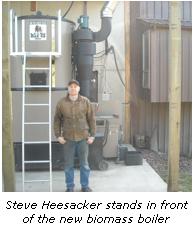 Hazelnut farmers recycle empty shells for hazelnut drying
Hazelnut farmers recycle empty shells for hazelnut drying
By Stephanie Page
Oregon Department of Agriculture
This coming fall, Steve and Karla Heesacker will not have to purchase propane to dry hazelnuts at their Forest Grove farm and drying facility. Instead they will use an agricultural resource in ample supply—“blank” hazelnut shells—to fuel a biomass boiler. This renewable energy project also offers significant cost savings.
In the past, the Heesackers typically used about 9,000 gallons of propane a year to dry hazelnuts from their farm and other local hazelnut farms. Between 2007 and 2009, their propane costs varied between $1.00 and $2.14 per gallon. At one point, they looked into having natural gas piped out to their farm, but the effort was not successful.
However, another potential source of heat energy was available right on the farm—“blank” hazelnut shells. The Heesackers separate the blank shells as well as sticks and other debris from other hazelnuts in a cleaning system before drying the nuts at their facility. The blank shells and sticks have a high energy content, making them an excellent heating fuel.
Steve Heesacker began researching biomass boilers online in 2009, and found the Max Ox boiler through Total Energy Solutions, LLC in Pennsylvania. He contacted the Oregon Department of Energy and Oregon Department of Agriculture about funding opportunities for such a project. The two state agencies, along with USDA Rural Development, worked with the Heesackers to successfully apply for a Business Energy Tax Credit (BETC) and a USDA renewable energy grant.
In the summer of 2010, Total Energy Solutions delivered and installed the boiler, and BCJ and Sons Mechanical Corp in Newberg installed heat exchangers and a dehumidifier.
“Total Energy Solutions connected an internet cable to the boiler, so they can monitor it from Pennsylvania and access it if I ever have a problem,” Steve Heesacker explains.
That fall, the Heesackers were able to test the system as they dried the year’s hazelnut crop. They expected that the blank shells would provide enough fuel to completely eliminate their need for propane, and this year’s supply turned out to be more than enough.
“The fuel didn’t burn as fast as we expected to get the heat we needed,” explains Steve Heesacker. “We had two times the expected number of blanks in 2010, so we had way more fuel than we needed.”
Steve Heesacker says he is pleased with the cleanliness and low maintenance required to operate the boiler. “The thing that surprised me is that you don’t have to be babysitting it all the time. I’m too busy that time of year to run it,” he explains.’
A tank stores the blank hazelnut shells, and a conveyor belt transports the shells to the boiler hopper. Sensors in the boiler hopper determine when fuel is getting low and send a signal to the conveyor belt to put fuel in the hopper; once the fuel reaches a certain level in the hopper, the conveyer belt automatically shuts off. Ash from the combustion process collects slowly in an ash bin attached to the system.
“I only had to empty the bin three times during the drying season,” Steve Heesacker explains. “It burns very clean – you can’t see anything coming out of the vents.”
The Heesackers worked with Washington County and the State Building Codes Division to permit the project. A mechanical permit was required from the county. The Building Codes Division boiler inspector helped the Heesackers design the boiler venting system so that a state permit would not be required.
“They just had us add an extra vent,” explains Steve Heesacker. “That made the system unpressurized, because of the double venting, so that annual inspections are not required.”
Altogether the project materials and installation cost approximately $99,000. “I also spent about $8,000 on engineering drawings as part of the county permitting process,” explains Steve Heesacker.
Assuming a propane cost of $1.70 per gallon, the Heesackers will recover the project cost in about seven years. The Oregon Business Energy Tax Credit and $20,000 USDA Rural Energy for America grant will accelerate the payback period.
The agencies involved in the project look forward to working with other agricultural producers and processors on similar projects. “This was such a great project and an excellent use of biomass fuel available on the farm,” explains Matt Krumenauer with the Oregon Department of Energy. “We think there are more farm-scale biomass project opportunities out there and look forward to working with farmers to support more of these systems.”
Disclaimer: Articles featured on Oregon Report are the creation, responsibility and opinion of the authoring individual or organization which is featured at the top of every article.

